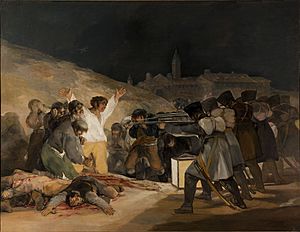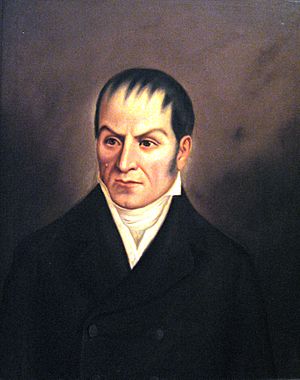Colombian Declaration of Independence facts for kids
The Colombian Declaration of Independence happened on July 20, 1810. On this day, a special group called the Junta de Santa Fe was formed in Santa Fe de Bogota. This city was the capital of the Spanish colonial area known as the Viceroyalty of New Granada. The goal of this group was to govern the territory on its own, without direct orders from Spain.
This important event helped inspire other independence movements across Latin America. It also started a rebellion that lasted almost ten years. This rebellion led to the creation of the Republic of Gran Colombia. This new country included what is now Colombia, most of Ecuador, Panama, and Venezuela. It also covered parts of northern Peru and northwestern Brazil.
Even though Gran Colombia later broke apart in 1831, it was once one of the strongest countries in the Western Hemisphere. It played a big part in shaping how other new countries in Latin America developed. Today, Colombia celebrates July 20 as its national independence day.
Contents
Why Independence Happened
For a long time, Spain ruled its colonies in the Americas very strictly. The Spanish kings wanted to control everything. They allowed some new ideas from the Age of Enlightenment to spread, but they kept tight political control.
One big problem was that Spanish colonies in the Americas were not allowed to trade with other countries. They could only trade with Spain. But Spain often couldn't provide all the goods the colonies needed.
Also, when King Charles III helped the United States become independent, it cost a lot of money. This led to new taxes in the Spanish colonies. These taxes caused anger and protests, like the Revolt of the Comuneros (New Granada).
Another major issue was that Criollos were kept out of important government jobs. Criollos were white people born in the Americas, but they were treated differently from people born in Spain.
King Charles IV, who ruled from 1788 to 1808, wasn't very interested in governing. He let his ministers, like the unpopular Manuel Godoy, handle most duties. King Charles IV cared more about art and science than about the American colonies.
The biggest change that led to the events of July 20, 1810, was a crisis in the Spanish royal family. In 1808, Napoleon Bonaparte forced King Charles IV and his son Ferdinand VII to give up their thrones. Napoleon then made his brother, Joseph Bonaparte, the new king of Spain.
Some Spanish people, called afrancesados, liked King Joseph at first. They were often educated people who thought working with France would bring modern ideas and freedom to Spain. For example, King Joseph ended the Spanish Inquisition. However, most ordinary people did not accept the new king. Opposition grew quickly after the French army started using harsh methods, like the executions on May 3, 1808, in Madrid.

Because of the crisis, an emergency government called the Supreme Central Junta was formed in Spain. Most leaders in the Americas promised to support this new Junta.
Criollos Speak Up
The Supreme Central Junta asked each major city in the Spanish American colonies to elect one representative. These representatives would then send instructions to the Junta.
A very important document called the Memorandum of Offences (or Memorandum of Grievances) was written by Camilo Torres Tenorio. He was a legal advisor for the city council of Santa Fe de Bogotá. In this document, he criticized Spain for not letting Criollos have high positions in the Americas. He argued that Criollos had a right to govern their homelands because they were "the offspring of the conquistadores."
Torres also said that Spanish Americans and people from Spain should be treated equally. He believed this was the only way to keep Spain and its colonies united:
-
- "There is no other way to bring America and Spain together than by giving its people fair representation. Everyone should be treated the same, based on their laws, customs, origins, and rights. Equality! This is a sacred right. Justice means giving everyone what they deserve. The true friendship between European Spaniards and Americans can only exist if there is justice and equality. America and Spain are two important parts of the Spanish Monarchy. Anyone who thinks differently does not love their country. So, to keep Americans from being represented would be a great injustice. It would also cause distrust and jealousy, and make them never want to be united. "
Torres argued that the Viceroyalty of New Granada had the right to form its own governing group (junta) because of the difficult political situation. Even though this document showed what many Criollos felt at the time, it was never officially adopted by the city council. It was only published much later, in 1832.
First Attempts at Self-Rule
As the war in Spain got worse, many Spanish Americans wanted to create their own juntas. They still said they were loyal to King Ferdinand VII. In Caracas, a plan to set up a junta in 1808 was stopped by the Captain-General, who arrested the people involved.
In what is now Bolivia, juntas were formed in Charcas (May 25) and La Paz (July 1809).
Closer to New Granada, in the area of Royal Audiencia of Quito (modern-day Ecuador), a group of Criollos formed the autonomous junta Luz de América on August 10. They swore loyalty to Ferdinand VII but rejected the Spanish authorities. The Viceroy of New Granada, Antonio José Amar y Borbón, saw this as an act of rebellion. Fearing similar events in New Granada, he ordered soldiers to stop the junta in Quito.
Spain's Government Changes
In mid-1810, news arrived that the Supreme Central Junta in Spain had broken up. A new temporary government, called a regency, had taken its place. Because of this new political crisis, Spanish people and Criollos in the Americas started forming their own juntas. They still claimed loyalty to King Ferdinand VII.
The next big event happened in Caracas, on April 19, 1810. The mantuanos (rich Criollos in Venezuela), along with military and church leaders, declared that their region was now self-governing. They still swore loyalty to Ferdinand VII but rejected the Spanish viceroy. The Spanish government in Cadiz then decided to remove Viceroy Amar y Borbón. They sent a messenger, Antonio Villavicencio, who arrived in Cartagena on May 8.
On May 22, in Cartagena de Indias, a local governing board was created, similar to the one in Caracas. Soon after, other cities like Santiago de Cali, Socorro, and Pamplona also took action against the Viceroy.
Finally, Bogota, the main city of the Viceroyalty, rebelled on July 20. At first, the new governing board named Viceroy Amar y Borbón as its president. But soon after, on July 25, he was removed and arrested. The spark that set off the rebellion was a small argument over a flower vase at a local businessman's house on the morning of July 20.
The Flower Vase Incident
On the morning of July 20, 1810, Joaquin Camacho went to the home of Viceroy Antonio José Amar y Borbón. He asked for permission to set up a governing board in Bogota, like those already in other cities. The Viceroy refused and acted very proudly. This made people angry.
Then, Luis Rubio went to the shop of José González Llorente, a businessman, to borrow a flower vase. He said it was for a dinner for the visiting Spanish commissioner, Antonio Villavicencio. But Llorente rudely refused to lend the vase.
As planned the day before, the Criollos then took the vase and broke it. They did this to make Llorente angry and to stir up the people against the Spanish. The Criollos knew Llorente would refuse because the vase was for sale, and he didn't like lending things to Criollos for their gatherings.
After this, a group of Venezuelans, including Francisco José de Caldas, swore loyalty to Spain. Antonio Morales Caldas then scolded him, which made the crowd even angrier. They tried to attack Llorente. The mayor of Santa Fe de Bogota, José Miguel Pey, tried to calm the people. Meanwhile, Jose Maria Carbonell encouraged everyone to join the protest.
That afternoon, a Junta (later called the People's Junta) was formed. José Acevedo was chosen as its chairman. But the crowds were upset when the Viceroy was nominated to be president of the Junta, and he accepted. Among the shocked crowd were soldiers from the local militia.
The Junta Declares Independence
Later, a meeting called by Juan Sámano, a Spanish Army officer, led to the Junta being reorganized. Acevedo had earlier urged the people to help charge Sámano for treason. The next day, July 21, the Junta ordered the arrest of Viceroy Amar y Borbón and his officials. They also demanded his resignation from the Junta presidency. On July 25, Amar was forced to resign and was arrested.
Five days later, on July 26, the Junta declared that it was completely cutting ties with the Spanish government. This meant the Junta officially declared the independence of what is now Colombia from Spanish rule. Bogota was the first city in the colony to break its ties with Spain. More provincial capitals followed in the coming months.
See also
 In Spanish: Independencia de Colombia para niños
In Spanish: Independencia de Colombia para niños
- Junta (Spanish American Independence)
- Public holidays in Colombia
- Republic of Gran Colombia
- Spanish colonization of the Americas
- Viceroyalty of New Granada
Images for kids



